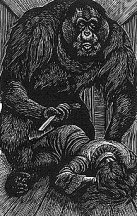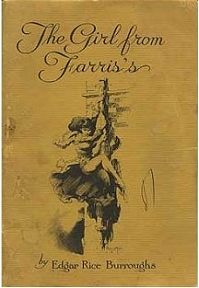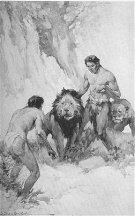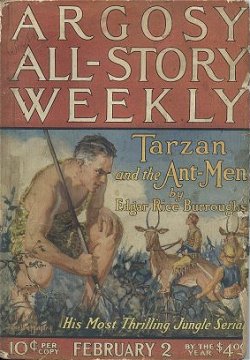II. Tarzan And Esteban Miranda
Now we turn to Tarzan and Esteban
Miranda, the second of the three stories of the novel. Without the
proper background one might find this story to be humorous as Miranda is
depicted as a slightly ridiculous figure. Of course the story turns
tragic in this volume of the diptych. However the early Miranda might
be a symbolical representation of Burroughs before his success as an author,
that is to say his life up to thirty-five years of age. Burroughs
found his early life slightly humiliating.
The problem of doubles in the
Tarzan series goes back to the very first novel - Tarzan
Of The Apes. Tarzan is at once the man-beast and the man-god.
Depending on how you want to look at it either a double with doubles or
a trinity. At any rate Tarzan represents human evolution from his
bestial ancestors to the divine. So while Burroughs said he found
religion outside the bounds of fiction the Tarzan series is one great long
religious treatise. As Burroughs was to say, if there was a new religion
it would not be represented by a supernatural being but by a man-god. He
may have been priming the Big Bwana as the archetype of the Aquarian Age.
Not as ridiculous as it may sound, the build up for the transition from
the Piscean Age to the Aquarian has been going on for well over a hundred
years just as it did for some centuries before the advent of the Piscean
from the Arien. It's just that without a background you wouldn't
recognize the signs. The mind must be prepared for the seed.
As one is admonished- don't throw pearls before swine and when the
student is ready the teacher will appear. Perhaps Burroughs was his generation's
teacher or one of them.
There can be no doubt that if
Tarzan is not a god he is repeatedly described as godlike.
There are a number of dualities
before we have this actual split in the Golden Lion-Ant Men novels.
Since the story runs over two novels it is obviously a major statement.
In addition to the man-beast
and man-god there is an actual duality between the human Tarzan and the
human Blacks. Nor do I think there is any doubt Burroughs considered
the Blacks to be an earlier stage of evolution than the Whites. Thus
any inferiority is innate and not relative. In the Carter Trilogy
he refers to the Martian Blacks as the First Born.
He picked up the phrase from
a Bushman reported by David Livingstone in his Missionary Travels In
South Africa, a book well worth reading. In it the Bushman says
that the Blackman was first created by God, who then made a better model
in the White man. As ERB was an evolutionist he probably took this
to heart which must be an evolutionarily sound notion. And so if
one reads and rereads the series the notion becomes more and more apparent.
Another duality is added when
the Porter party is set ashore at his father's cabin. At this point,
having been a beast and a Negro, Tarzan evolves into a White but without
the thin veneer of civilization. While genetically superior to the
Blacks he is still at the same level of evolvement. The thin veneer
will be added to complete his transformation when Paul D'Arnot takes him
to Paris. However, as ERB says, Tarzan's 'thin veneer of civilization'
was no deeper than his clothes. With his clothes off Tarzan reverted
to his natural state as the man-beast. Even if his thin veneer was gone
he must still have had memories of it.
 In a way then Tarzan and D'Arnot are a duality much as the narrator and
his double in Poe's Murders In The Rue Morgue on which this duality
is undoubtedly based. Certainly Poe was on ERB's mind in the first
two novels as attested by Chapter III, "What Happened In The Rue Maule"
of The Return Of Tarzan.
In a way then Tarzan and D'Arnot are a duality much as the narrator and
his double in Poe's Murders In The Rue Morgue on which this duality
is undoubtedly based. Certainly Poe was on ERB's mind in the first
two novels as attested by Chapter III, "What Happened In The Rue Maule"
of The Return Of Tarzan.
And then Tarzan is also seen
as two personas by Jane Porter -- one as the Tarzan who helps them and
one as the mysterious jungle wild man and of course the Ape Man is also
Tarzan Of The Apes and John Clayton, Lord Greystoke.
So the personality was fractured
if not split from the beginning. Tarzan has so many identities he
doesn't know who he is.
As Korak the Killer almost duplicates
Tarzan's life in Son of Tarzan he might also be seen as a double.
But the first real split occurs in the Jewels Of Opar when the roof
falls on Tarzan's head during the earthquake. This produces a case
of full blown amnesia not unlike that of Esteban Miranda is this novel.
Here an actual lookalike double is produced that allows Tarzan to be in
two places at once. Burroughs can dissociate himself from his detestable
earlier existence.
Probably the distresses of success
got to ERB in 1915 that had his mind coming and going as he tried to adapt.
You have to remember that he may have been only partially responsible for
his actions as the concussion suffered in Toronto was still probably affecting
his actions. In a way he was trying to run away from the stresses
of his success in his cross-country auto trip in 1916.
Now that he had added the terrific
stresses of running a large ranch like Tarzana coupled with the developing
financial disaster of his mismanagement of the estate he shredded his personality
into two distinct halves. One was his real self who while capable
enough was incompetent to deal with his new burdens. The other was
his ideal self, Tarzan, who never met a challenge he couldn't handle.
While in real life Burroughs did save himself from a complete financial
disaster he was able to salvage enough self-respect to meld his personality
back into one, at least temporarily or on the surface, as another double
will appear as he is divorcing his wife, Emma. While he allows Miranda
to live at the end of Ant Men he kills off his other self, Stanley
Obroski in Tarzan And
The Lion Man. ERB may have thought that he had become wholly
Tarzan at that point.
As Golden Lion ended,
Tarzan's double Miranda had been captured by the cannibal chief Obebe.
Obebe wanted to kill and eat Miranda but his witch doctor, Khamis, swore
Miranda was The River Devil wanting to keep him captive. In this
contest between the temporal power of the state and the religious power,
as in real life so often happens, the religious power wins out. So
Burroughs deals with both topics he says fiction writers should leave alone.
The real Tarzan will appear to
avenge the indignities placed on the faux Tarzan but Burroughs' real objective
here is to reenact the blow, once again, that he received in Toronto and
explain his subsequent behavior. As usual the sly dog gets away with
things no other writer of his time did.
Miranda escapes when he
persuades a fourteen year old girl named Uhha that he is indeed The River
Devil and that she will reap great rewards by freeing him. The name
Uhha is taken from Stanley's Through The Dark Continent. As
these events take place somewhere near or in the Ituri Rain Forest Burroughs
is describing Stanley's Africa.
Once freed, Miranda abducts the
girl. She quickly learns that he is neither The River Devil or Tarzan
as neither would be afraid. Having lost her respect for him she plans
an escape but she wants revenge. She doesn't know what diamonds are
but as she watches him fondle them every night she knows that he values
them She plans to steal them.
Miranda keeps this bag of jewels
under his loin cloth so sly old Burroughs has the jewels next to the family
jewels. Perhaps another way of saying that what a man values most
is his manhood. Now he has Miranda, the Tarzan lookalike, bed down
with a fourteen year old Black girl. Zips right by you the way it
is written but Miranda is actually sleeping with the girl.
She waits until he is sleeping
and then, pp. 73-74:
Presently the Spaniard's breathing indicated that he was asleep.
Uhha waited a little longer to make assurance doubly sure, then she reached
beneath the grasses just beside her and when she withdrew her hand again
she brought forth a short, stout cudgel. Slowly and cautiously she
rose until she kneeled beside the recumbent form of the sleeping Spaniard.
Then she raised her weapon above her head and brought it down once, heavily,
upon Esteban's skull.
Then she takes his knife and cuts
his loin cloth away and removes the bag or sac qua family jewels from his
exposed groin. A perfect act of castration or Emasculation.
Certainly Burroughs is reenacting
symbolically here his own bashing in Toronto which had the effect of emasculating
him. Shall we say his character was changed as he wandered half groggy
through the streets of Chicago hardly knowing where he was? Here's
how Burroughs describes Miranda's awakening, pp.74-75:
When Esteban regained consciousness...He felt weak and dizzy and his head
ached. He put his hand to it and found his hair thick with coagulated
blood. He found something else as well-- a great wound in his scalp
that made him shudder and turn sick, so that he fainted.
This is not an exact replication
of what happened to Burroughs in 1899 in Toronto but it certainly describes
what his situation had been. The man had a serious injury, the consequences
of which would plague him for years if not for life. In a letter
to the Editor of the BB NS#59 also included in my Four
Crucial Years Pt. IV on ERBzine I posited the following taken from
Per Brodal: The Central Nervous System: Structure And Function,
3rd Ed. p. 433:
A peculiar form of amnesia occurs together with confabulation: that is
the patient invents stories (without knowing they are not real).
Most of the patients have a lesion involving the substantia innominata,
the medial hypothalamus, and the orbito frontal cortex (usually caused
by a ruptured aneurysm in the anterior cerebral artery). The often
bizarre stories can usually be traced back to real events although they
consist of various unrelated fragments from memory. It seems the
patient is unable to suppress irrelevant associations, and cannot check
them against reality.
My discovery was treated with a
fair amount of derision, but ERB describes almost the exact symptoms here
and following. His story is certainly bizarre enough and it can be
traced back to real events. Let us pursue Esteban's injury.
Pp. 84-85:
He was sitting up now and presently he regarded his nakedness in
evident surprise. He picked up the loincloth that had been cut from
his body. Then he looked all about him on the ground--his eyes dull,
stupid, wondering.
---
He was naked but he did not know it. His diamonds were gone, but
he would not have known a diamond had he seen one. Uhha had left
him, but he did not miss her, for he knew not that she had ever existed.
Blindly
and yet well, his muscles reacted to every demand made upon them in the
name of the first law of nature. He had not known why he leaped to
a tree at the sound of Numa's growl, nor could he have told why he walked
in the opposite direction when he saw where Numa lay up with his kill.
He did not know that his hand leaped to a weapon at each new sound or movement...
Uhha had
defeated her own ends. Esteban was not being punished for his sins
for the very excellent reason that he was conscious of no sins nor of any
existence. Uhha had killed his objective mind. His brain was
but a storehouse of memories that would never again be raised above the
threshhold of consciousness. When acted upon by the proper force
they stimulated the nerves that controlled his muscles, with results seemingly
identical with those that would have followed had he been able to reason.
An emergency beyond his experience would consequently have found him helpless,
though ignorant of his helplessness. It was almost as though a dead
man walked through the jungle.
 That's a very good almost clinical description but it is absolutely unnecessary
to the story. Burroughs is compelled by his horrific memories to
tell it now just as he has been telling variations on the theme in every
story. The Girl
From Farris's is almost as complete as this while describing
Burroughs real life reaction.
That's a very good almost clinical description but it is absolutely unnecessary
to the story. Burroughs is compelled by his horrific memories to
tell it now just as he has been telling variations on the theme in every
story. The Girl
From Farris's is almost as complete as this while describing
Burroughs real life reaction.
Once hit on the forehead rupturing
the anterior cerebral artery the bleeding collected between the prefrontal
lobe and the skull forming a clot. This may have progressively worsened
over a week or two. The resulting pressure caused Burroughs severe
headaches as in his description here and caused his inability to remember
faces and names which resulted in so much grief for him as related in Girl
From Farris's.
Burroughs took heroic measures
to combat this problem rather than giving in. He undertook health
measures probably inspired by the regimes of Bernarr Macfadden. Porges
apparently found no records of medical treatment in his examination of
the archives yet in both Girl and Ant Men Burroughs mentions
medical treatment. Records of such may yet exist in the Tarzana archives.
In Ant Men Burroughs tells
of medical treatment in this way. Miranda disappears into the jungle.
The faithful Waziri Usulu discovers him feeding off a rotting carcass that
the vultures apparently overlooked. Thinking him the Big Bwana, and
by this time familiar with the Big Guy's periodic amnesias, he leads him
back to the Estate.
As he was a babbling idiot Jane
went to London to enlist the services of a great London brain specialist.
The Great One examined the patient. P. 185:
There was pressure on the brain from a recent fracture of the skull.
An operation would relieve the pressure and might restore the patient's
mind and memory. It was worth attempting.
 The operation was performed and apparently was successful. As Jane
was about to embrace Esteban, Flora Hawkes, the new maid from Golden
Lion, recognized Miranda as himself. Tarzan at the same time
steps into the room returning from the Ant Men three inches shorter.
He and Jane are reunited.
The operation was performed and apparently was successful. As Jane
was about to embrace Esteban, Flora Hawkes, the new maid from Golden
Lion, recognized Miranda as himself. Tarzan at the same time
steps into the room returning from the Ant Men three inches shorter.
He and Jane are reunited.
What happened to the double is
left undecided until Tarzan
And The Lion Man when ERB will kill him off in the person of the
double, Stanley Obroski.
Thus the rather remarkable
and exciting story of Esteban Miranda and Tarzan comes to its close.
One should read the diptych of Golden
Lion and Ant Men together to get the full flavor of this
strange and wonderful story.
As I say, next to Tarzan I consider
Esteban to be one of ERB's finest creations.


 In a way then Tarzan and D'Arnot are a duality much as the narrator and
his double in Poe's Murders In The Rue Morgue on which this duality
is undoubtedly based. Certainly Poe was on ERB's mind in the first
two novels as attested by Chapter III, "What Happened In The Rue Maule"
of
In a way then Tarzan and D'Arnot are a duality much as the narrator and
his double in Poe's Murders In The Rue Morgue on which this duality
is undoubtedly based. Certainly Poe was on ERB's mind in the first
two novels as attested by Chapter III, "What Happened In The Rue Maule"
of  That's a very good almost clinical description but it is absolutely unnecessary
to the story. Burroughs is compelled by his horrific memories to
tell it now just as he has been telling variations on the theme in every
story. The Girl
From Farris's is almost as complete as this while describing
Burroughs real life reaction.
That's a very good almost clinical description but it is absolutely unnecessary
to the story. Burroughs is compelled by his horrific memories to
tell it now just as he has been telling variations on the theme in every
story. The Girl
From Farris's is almost as complete as this while describing
Burroughs real life reaction.
 The operation was performed and apparently was successful. As Jane
was about to embrace Esteban, Flora Hawkes, the new maid from Golden
Lion, recognized Miranda as himself. Tarzan at the same time
steps into the room returning from the Ant Men three inches shorter.
He and Jane are reunited.
The operation was performed and apparently was successful. As Jane
was about to embrace Esteban, Flora Hawkes, the new maid from Golden
Lion, recognized Miranda as himself. Tarzan at the same time
steps into the room returning from the Ant Men three inches shorter.
He and Jane are reunited.
